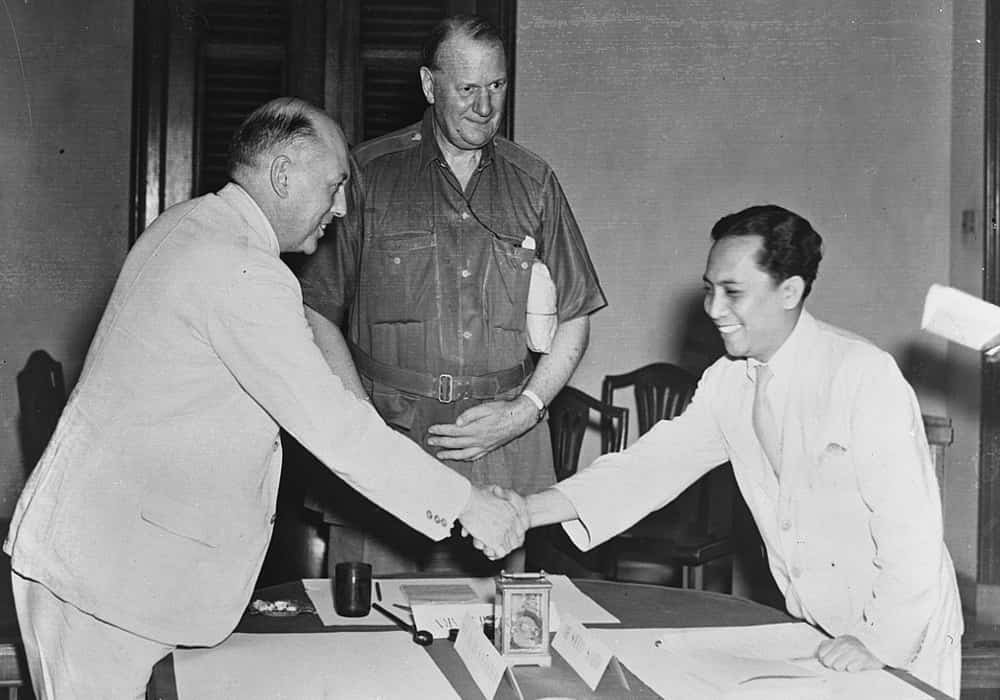Linggarjati Agreement (Linggadjati)
The Linggarjati Agreement is the political agreement concluded on November 15, 1946 by which the Netherlands officially recognized the existence of the Republic of Indonesia and which marked the first major diplomatic agreement of the Indonesian Revolution. The Netherlands were represented by Governor Hubertus van Mook and Indonesia by Prime Minister Sutan Sjahrir.
Linggarjati Agreement Background
In the spring of 1942, the Dutch East Indies was invaded by the Japanese. During the years of the Japanese occupation, the Indonesian nationalists, in cooperation with the occupying Japanese authorities, succeeded in laying the foundations of a future independent state, and after the Japanese surrender, while Dutch rule had not yet returned, Indonesian independence was proclaimed on 17 August 1945. The returning Dutch government attempted to restore the pre-war status quo, and the Indonesian War of Independence began.
Read also: Renville Agreement Between the Netherlands and Indonesia (1948)
The Netherlands was weakened by World War II, and in October 1946 an armistice was proposed. The Indonesian side accepted the ceasefire proposal, and on November 11-12, Indonesian and Dutch representatives held talks in the village of Lingajati on the island of Java, which resulted in an agreement.
Police Action (Politionele Actions)
Politionele Acties (Dutch for “police action”) refers to the two major military attacks carried out by the Dutch in Java and Sumatra against the Republic of Indonesia during its struggle for independence in the Indonesian National Revolution. In Indonesia they are collectively known as Dutch Military Aggressions (‘Dutch Military Aggressions’), although the term Police Action is also known.
- Product Operations lasted from 21 July to 5 August 1947.
- Operation Kraai lasted from December 1948 to January 1949.
This rebellion was mainly guerrilla by Indonesian nationalists against Dutch troops
The Dutch government did not recognize the Republic of Indonesia as an independent country, but considered it a rebellion movement in the Dutch East Indies colony.
It should be noted here that, in the Linggadjati (Linggarjati) agreement discussed below, the Republic recognized Dutch sovereignty during the transition period. Actually, this is not a war but a rebellion. The Netherlands de facto recognized the Republic in the same treaty.
In traditional Dutch historiography and in the Dutch media this episode is often referred to by the term ‘police action’ which was used by the government at that time (also called ‘police action’, Indonesian language: Police action). It was the name for two offensive operations, lasting several weeks, by the Dutch armed forces during the Indonesian National Revolution. This operation took place on the islands of Java and Sumatra from 21 July to 5 August 1947 (first action, “Operation Product”) and 19 December 1948 to 5 January 1949 (second action, “Operation Crow”) and the aim was to restore Dutch control over the regions. certain.
Therefore, the actions of the police were not the same as – but part of – the struggle for Indonesian independence. This rebellion was mainly guerrilla by Indonesian nationalists against Dutch troops. The hostilities lasted until a ceasefire on the night of 10-11 August 1949. After that, fighting broke out in several places, which resulted in the death of Dutch soldiers as well.
During nearly 4 years of the Dutch military presence in Indonesia, around 5,000 Dutch soldiers lost their lives, about half of them as a result of the fighting. The rest died from illness and accidents. Tens of thousands of people were killed among the Dutch (Indonesian) civilian population, as well as among Moluccans and Chinese, as a result of acts of violence by Indonesian nationalists. On the Indonesian side, at least 97,000 people died as a result of the Dutch military action, both soldiers and civilians. In addition, there is a plurality of violence among Indonesians themselves. The Madiun incident has killed 35,000 communists.
After 1949, the struggle (besides the coup against former Captain Westerling in 1950) flared up once again. It was during hostilities before the surrender of Dutch New Guinea in 1962.
Contents of the Linggarjati Agreement
The agreement was made in Linggardjati (modern Indonesian spelling Linggarjati), a mountain village in West Java.
For the Netherlands, Lieutenant Governor-General Van Mook left his mark on the negotiations that took place on 11 and 12 November; for Indonesia, namely Sjahrir.
Soekarno and Hatta were also present at the signing on November 25, 1946 at the Rijswijk palace in Jakarta (now known as the State Palace).
In short, the agreement covers the following:
1. The Netherlands de facto recognized republican power over Java, Madoera and Sumatra.
2. The areas occupied on these islands by Dutch troops or their allies were ‘included’ into the territory of the Republic.
3. The Netherlands and the Republic work together “to establish a sovereign democratic state on a federative basis, called the United Republic of Indonesia”, which will cover “the entire territory of the Dutch East Indies” as soon as possible.
4. The United States of Indonesia currently consists of three states: the Republic, Kalimantan and the Great East.
6. The Kingdom of the Netherlands (i.e. with Suriname, Netherlands Antilles and Dutch New Guinea) and Indonesia formed the Dutch-Indonesian Union, headed by the Crown of the Netherlands (ie queen/king).
All of this had to be arranged before January 1, 1949.
Results and consequences
On March 25, 1947, the House of Representatives of the Dutch Parliament ratified the truncated treaty, which was rejected by the Indonesian side. Further disagreements led to the fact that on July 20, 1947, the agreement was terminated by the Dutch side.
Sources: PinterPandai, Jstor, Wikia, Local Histories, BBC, World Atlas
Photo credit: Wikimedia Commons
Photo description: Negotiations and signing of the ceasefire agreement; Linggadjati Conference with from left to right: Schermerhorn, Lord Killearn and Sutan Sjahrir.
Date: October 14, 1946.
Location : Batavia, Indonesia, Indonesia, Dutch East Indies.



